Final Report for LNE12-316
Project Information
The goals of this project were to encourage the adoption of tile drainage by Massachusetts cranberry growers and to use on-farm research and grower feedback to develop Best Management Practices (BMPs) for tile installation and use. The project included 6 research/extension scientists and 8 grower advisors, 2 of whom provided sites for large-scale field experiments. Research results confirmed the consensus practice of growers that a 20-foot spacing between the tiles provides adequate but not excessive drainage and accommodates common in-ground irrigation designs. We learned from research and grower experiences that the optimum depth for tile installation is site-specific, depending on soil texture, sub-grade depth and composition, and site hydrology. These results were presented at 3 large grower meetings and 2 on-farm workshops reaching 300 cranberry growers, and were summarized for distribution in a 13-page fact sheet and BMP document.
Over 200 cranberry growers were surveyed at the end of the project; 85 responses were received from growers who were the decision-maker for the farm. These growers represented 64% of the 2016 Massachusetts cranberry acreage. During the project they installed tile on 747 acres (6% of the MA acreage) and planned to install on an additional 347 acres by the end of 2017. Of those who installed tile since 2012, 37% reported that information from this project changed how they used tile or encouraged them to use tile for the first time. Of the 39 growers who installed tile into existing cranberry beds (retrofit), 70% reported increased yield and improved fruit quality (less fruit rot).
Introduction:
While cranberry is a wetland crop, dependent on abundant water supply, improper drainage can result in increased root rot and fruit rot diseases, inhibition of root development, reduced fruit retention and reduced productivity. However, maintaining optimal saturation levels and draining ponded water remains a challenge for many cranberry growers in southeastern Massachusetts. Improved water management could significantly impact the cranberry industry in Massachusetts, where ~400 growers manage approximately 12,500 acres and produce a crop valued at $80,791,000 in 2014 (National Agricultural Statistical Service, 2014).
Growers have expressed interest in techniques for effective and cost-efficient management of drainage. Subsurface tile drainage (i.e., shallow subsurface lines of 4-in-diameter perforated plastic pipe) has the potential to be used for this purpose. A common practice in other crops, tile drainage is a relatively new management practice in cranberry cultivation. Despite the lack of research on tile drainage in cranberry, Massachusetts growers had started to adopt this practice for water management, with a 2009 survey (NE SARE project LNE 05-217) showing that 39% of 102 growers had begun to install drains on their farms.
Subsurface tile drainage can also be used to reduce overhead irrigation usage by effectively managing water from below. Water levels in perimeter ditches can be raised, allowing water to flow through the tile drainage into the interior of the bog. Ideally the root zone could be kept wet via capillary rise while the soil surface would remain dry much of the time. Energy cost savings could be realized since irrigation pumps can run less frequently.
Despite a high level of interest in tile drainage among Massachusetts cranberry growers, there was little research on this topic and best management practices (BMPs) for tile drain installation in cranberry did not exist.
This project was designed to fill those gaps. By working on grower farms to investigate tile spacing (vertical and horizontal) and function, a knowledge base was generated that, along with grower experiences, was used to develop BMPs. As part of the project, growers learned about the utility of drainage tile at educational meetings, at on-farm workshops, and through written materials posted to the UMass Cranberry Station website.
After assessing current practices and challenges in an initial survey and a group interview with the project grower team, two experiments were conducted on grower farms to quantify optimal design parameters for tile drainage systems and to assess tile function and interaction with nitrogen management. The research developed information on drain spacing and depth of installation while evaluating plant responses, hydrological behavior, and the impact of various drainage installations on incidence of plant diseases (Phytophthora root rot and fruit rot). BMPs for tile-drainage systems were developed based on data from those experiments combined with on-farm experiences with tile drainage shared by participating growers.
Change in grower practice (behavior) was assessed with periodic surveys (written) conducted at the UMass Cranberry Station Annual Update Meeting held each January. The final survey (January 2016) was followed up by phone and in-person interviews, two of which were filmed for posting to our YouTube site.
Performance target: Fifteen growers install tile drains on a total of 140 acres (1% of MA acreage) with five incorporating project-developed BMPs for installation, maintenance, and irrigation supplementation, resulting in increased yield of 20 barrels/acre (~$850/acre), reduction of sprinkler irrigation cycles (quantified energy and water savings), and the elimination of at least one pesticide application per year.
In our final survey, of the 57 growers who reported having tile drains on their farms, 31 installed tile drains during this project, accounting for 747 acres of installations. Two of the respondents with large acreage followed the recommendations that came out of this project and plan to use their tile drainage system to supplement irrigation (personal interviews). Due to lack of ability to convince growers to keep and share records regarding their tile installations, we are not able to confirm how many followed recommended practices. However, we believe that most did based on informal conversations held throughout the project. Likewise, we were not able to get hard numbers regarding water savings or yield increases. However, in our final survey, of 39 growers who installed tiles into existing beds (retrofits), 70% reported increased yield and better fruit quality (therefore having fewer deductions in their deliveries). Of those growers who installed tile in renovated or new beds only, since such activity also involves planting more productive cultivars, crop yield certainly would have increased on their bogs, but not necessarily entirely due to the inclusion of tile drains.
We had anticipated the potential to reduce fungicide use once tiles were installed. However, this did not emerge in our surveys or conversations with the exception of those growers who retrofitted tiles to manage Phytophthora root rot. With improved drainage, they were able to discontinue the use of fungicides once the infection was under control. We believe that in the future, improved water management, including the use of tile drains along with improved irrigation management, will allow growers to manage fruit rot disease with fewer fungicide applications. Further work on the integration of water and disease management is required.
Cooperators
Research
After assessing current practices and challenges via an initial survey and in a focus group meeting with project participant growers, optimal design parameters for tile drainage were quantified in two experiments. Our overall approach was to engage cranberry growers as host/participants for the two on-farm experiments and/or as participants who install and evaluate drains on their farms (using best current practices).
A fact sheet regarding the use of tile drainage and BMPs for tile-drainage systems were developed based on research results and on experiences gathered from participating growers’ farms based on hydrological monitoring, detailed measurements of crop yield and plant physiology, and disease response. Those growers also shared their experiences with tile drains to aid in the development of BMPs.
Growers were surveyed during the project and at the project end (January 2016) to document change in practice. Growers were also interviewed by phone and in person.
Specific methods and design:
Experiment 1 - Tile hydrologic function and relationship to nitrogen transport.
This was the project undertaken by our graduate student Nickolas Alverson. On the farm of one of our grower project advisors, a single 5-acre bed was chosen for study. This bed had tiles spaced at about ~20 feet apart and between 18-24 inches deep (from the surface to the bottom of the tile). There were 7 tiles running lengthwise in the bed which was renovated and replanted in 2010. The pipe was not encased in a 'sock' (mesh material). 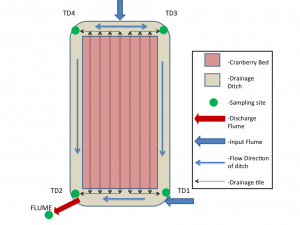
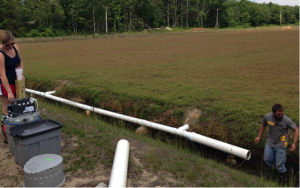
PVC pipe was used to join the ends of groups of tiles so that composite drainage would be quantified using compound weirs and area-velocity meters and water could be sampled for nutrients using automated equipment. Photos of the setup and project design are shown in the attached poster and fact sheet. Irrigation water was quantified using a propeller flow meter on the irrigation pump, soil tension was monitored with tensiometers, groundwater level was monitored in a shallow well installed in the center of the bed, and composite water samples were collected weekly for nutrient analysis.
The data collected were used to construct a hydrologic budget for the site as well as a nitrogen budget.
Experiment 2 - Tile depth and relationship to soil moisture, plant function, crop yield and fruit quality.
The study was set up at a 30-acre bog belonging to one of the project grower advisors. Separated by dikes and flow-control structures, seven fields comprise the farm, and include production areas on natural wetland soils and artificially constucted beds with mineral soils referred to as upland bogs. The research was carried out on the two cranberry fields, PF1 (natural wetland soil) and PF7 (mineral soil), that were renovated and replanted with the Stevens cultivar in 2013 (site PF1) and 2011 (site PF7). For both sites, the subgrade was re-leveled and “keyhole” trenches were dug into the subgrade at every 20 ft, corresponding to the future location of the tiles. The keyholes were filled with sand, the tiles placed on top of the keyhole and then a layer of sand was distributed across the bed and vines were planted. Tile drains were installed at two depths below the soil surface for site PF1 (8 and 12 inches to the bottom of the pipe) and at one depth for site PF7 (12 inches).
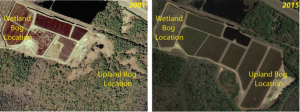
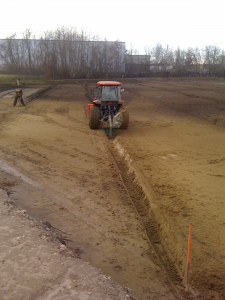
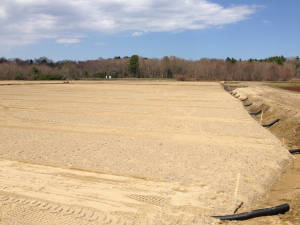
The study combined a replicated field trial and a field demonstration to identify causes of poor drainage in cranberry farms and compare functionality of tile at two depths. The location of the replicated field trial is site PF1, where tile drains were installed at depths of 8 inches (“shallow tile drainage”) and 12 inches (“deep tile drainage”) below the soil surface to the bottom of the tile, based on grower surveys of their common practice regarding tile depth. These groupings were replicated three times for each depth. Soil tension and crop yield were measured in sections of PF1 with shallow and deep tile drainage. For the field demonstration, mean values of soil tension, crop yield, and fruit rot were compared between sites PF1 and PF7. A ground penetrating radar (GPR) survey was conducted in late March, 2016. Across the seven cranberry fields, a total of 21 transects were run. Graphics and photos showing site design are also included in a fact sheet on cranberry tile drainage (see information products).
Grower surveys
Growers were presented with written surveys at the UMass Cranberry Station winter meetings from 2012-2016. The 2012 survey provided baseline data regarding grower practices and the 2016 survey was used to determine changes during the project. The other surveys were used to keep the project in front of growers and to gather interim data. Survey results were compiled. LNE12-316_Survey_Summary_2012-2014 LNE12-316_2015_grower_survey LNE12-316_2016_final_grower_survey
Educational materials
Project information and results were presented in poster, handout and PowerPoint presentation formats at the January meetings and at the Cape Cod Cranberry Growers Association (CCCGA) March meeting in 2014. Attendance: 2012 = 280; 2013 = 290; 2014 = 262; 2014 CCCGA= ~250; 2015 = 176; 2016 = 220.
LNE12-316TileDrainagePoster LNE12-316_2014_Update_Mtg_ Presentation LNE12-316_2016_Update_Mtg_ Presentation
A tile drain specific bogside workshop was conducted in May 2015 at the location of Experiment 1 (attendance 16). The workshop planned for the Experiment 2 site had to be abandoned due to logistical issues. We held a bogside workshop in June 2106 at a site that had tiles installed in renovated beds (attendance 13). In fall 2016 or spring 2017, we will present a bogside workshop showcasing the actual installation of tile as it is retrofitted into the bog at the UMass Cranberry Station. This was originally planned for spring 2016 but the grower who was to do the installation was not able to fit us into his schedule.
During the final months of the project, we developed a fact sheet and a BMP document, both of which have been posted to the Cranberry Station Website (http://ag.umass.edu/cranberry). These documents will be advertised in upcoming newsletters and will be handed out at the January 2017 winter meeting, during which we will present a wrap-up of the project. They can be viewed in the information products section.
We also conducted on camera interviews of farmers who use tile drains. That video is posted to the Cranberry Station YouTube site (https://www.youtube.com/watch?v=xLgedsxZjgQ).
What didn't work:
Growers were reluctant to volunteer to install tiles and work closely with our team. As a result, there were no participants willing to keep and share records of farm practices before and after tile installation. We tried to overcome this by soliciting information about the outcomes realized by growers who undertook tile installations during the project years independent of our direct participation. This impacted our ability to gather hard numbers regarding water savings or crop yield.
Original milestones with comments on completion or challenges:
- Five growers sign on as early adopter participants/project advisors; one provides the site with varied horizontal spacing. completed 2013
- 300 growers learn about project including data collection requirements of those that participate and receive a survey regarding current drainage practices and challenges. completed 2013
- 200 return survey, 150 are interested in additional education, 30 are interested in establishing drainage for project evaluation.
Surveys were conducted in January 2012 (n=171), 2013 (n=118), 2014 (n=115) and 2015 (n=90).
- Five growers install tile drains with guidance from the project team and advisors. They begin to keep records of management activities using the template provided by the team.
The largest grower on the project team is planning a twenty-year project of adding 100 new acres - these will include tile drains. The planning for this installation has included consultation with the project scientists. In the January 2015 survey, 31 respondents reported installing tile in 2013, 22 installed tile in 2014. Unfortunately, no grower was willing to participate in record keeping, so that aspect of the project was not accomplished.
-
At the end of the first year, growers and team members have produced a first draft of the BMP and have selected the site and horizontal spacings for Experiment 2.
Horizontal spacing experiment was completed by 2013 and additional evaluation of a ~20-foot spacing continued through the 2015 growing season. The vertical spacing (depth) experiment (2) was established in 2014 and completed in 2015. The BMP was completed in 2016. -
Early adopters evaluate practices on their farms and host on-farm workshops. The team conducts and evaluates Experiment 2 and meets individually with early adopters to confirm participation and record keeping.
Data from the evaluation of the vertical spacing site (exp. 2) were gathered and reported in 2015. An on-farm workshop was held at the ~20-foot spacing site (graduate student project) in May 2015. This site was also used to study tile hydrologic function and potential for transporting nitrogen. Unfortunately, no grower was willing to participate in record keeping so that aspect of the project was not accomplished. - Growers attend on-farm workshops, sign up for personal design and installation assistance and follow-up. Interim information is disseminated at winter meetings and brief surveys are conducted at the meetings to verify progress towards performance target.
The tile function evaluation study (~20-foot spacing) of graduate student Nick Alverson was presented in poster format at the 2014 UMass January grower meeting (attendance 262) along with a PowerPoint presentation by Casey Kennedy of that study and the tile depth work (Exp. 2).The site for Nick's study was the location for an on-farm workshop in May 2015 (attendance 16). Due to this low attendance, we decided to limit on-farm workshops, planning for a final one in early 2016. That workshop (planned for the site of Exp. 2) did not happen due to liability concerns of the farmer that could not be resolved. However, we did hold an on-farm workshop in June 2016 (attendance 13) intended to focus on application equipment. Since that grower had installed tile drains in renovated beds at the site, we covered that topic as well. We had hoped to retrofit some tile at the Cranberry Station bog in the spring of 2016 and hold an open house for growers to observe the process. However, this had to be postponed until post-harvest 2016 or spring 2017 due to unavailability of the grower who was to install the drains for us.
Dr. Kennedy presented project results at the winter meeting of the Cape Cod Cranberry Growers Association in March 2014 (attendance approx. 250). Surveys were conducted at the 2014 and 2015 UMass January grower meetings.We were unable to solicit growers for design assistance sessions.
-
10 new adopters have installed drainage and are evaluating the practice (using the provided template) by Year 3 (at least half have installed and manage their drains based on developed BMPs – these are in draft form during Year 2 and finalized in Year 3). The team meets with adopters during the season to evaluate progress and confirm recordkeeping.
In the January 2015 survey, 31 respondents reported installing tile in 2013, 22 installed tile in 2014. A subset of those growers was slated to be interviewed in early 2016 about their experiences. The BMP was not yet completed so installation designs were based on information provided at workshops or in conversations with researchers and growers. As mentioned, growers were not willing to use the template to keep records or in fact, to formally work with our team during the installation of tiles on their farms.
-
300 growers are educated on best management practices from the project, are surveyed at grower meetings and receive a fact sheet outlining BMPs (this is also posted online).
Carolyn DeMoranville presented a summary of project research at the UMass grower meeting in January 2016 (attendance 220) that included the basics of what were to be the BMP guidelines. LNE12-316_2016_Update_Mtg_ Presentation
The actual BMP document as well as a more detailed fact sheet on tile drains were produced during the summer of 2016 and have been posted to the Cranberry Station website. Growers will be informed of their availability via newsletter and hard copies will be distributed at the 2017 UMass January grower meeting, at which event we will present the final project outcomes. LNE12-316TIle_Fact_Sheet LNE12-316_Tile_BMP -
A final phone and in-person survey of adopters gathers records and is used to determine if the performance target has been met.
As was the case throughout this project, finding growers willing to share records proved impossible. However, we did interview several growers, including ones from two farms who were willing to be interviewed on tape. The video of their interviews has been posted to the Cranberry Station’s YouTube channel (https://www.youtube.com/watch?v=xLgedsxZjgQ).Those interviews, along with our final written survey (January 2016) formed the basis to determine that we had met the performance target in terms of adoption. However, we were not able to get hard numbers on costs and returns (see the performance target section).
Grower surveys in from 2012-2016 showed that, consistently, larger acreage growers were more likely to have tile drains on at least some of their acres and were most likely to install additional drains. The barrier for smaller growers appeared to be primarily financial, with the majority of growers (large and small) viewing tile drainage as an advantageous practice. It was about equally likely, based on the 2015 survey, that those installing tiles were retrofitting existing beds (61%) vs. installing tile in renovations or new plantings (42% and 17% respectively).
Based the 2015 survey, drain tiles were installed by 31 growers in 2013 and 22 growers in 2014. This was confirmed in an interview with a grower (not part of the project team) who has provided custom retrofit installation services to other growers in addition to installing tiles on his own farm. This grower will provide the installation services for the retrofit (into an existing bed) of tiles into the bog at the UMass Cranberry Station later in 2016 or in early 2017. This installation will include an open house to view the techniques used and the production of a video to be posted to the Cranberry Station YouTube site. He met with three of the project scientists in the fall of 2014 at his farm where he discussed his experiences and showed his tile installations. He noted that on one of the retrofitted beds, he put the tiles into the subgrade and was not satisfied with the results. To compensate, he added surface ditches. It was only after those additions that the bed began to increase in yield, approaching that produced on beds that had been retrofitted with shallower drains.
Survey responses continued to confirm the information provided by the team of 5 early adopters: most Massachusetts growers were installing drains at a depth of 6-12 inches (measured to the top of the pipe), owing to a relatively shallow peat layer and a paucity of accessible sand (at least by comparison to farms in Wisconsin and the Quebec Province of Canada), and that the 20-foot horizontal spacing is the most common. That horizontal spacing accommodates working around existing sprinkler pipe spacings, especially important in retrofits. We focused on retrofit applications for several reasons - they can be used to drain isolated wet areas of beds (identified as a primary motivation for growers to use tile drains) and they can be done as spot or partial installations, saving money.
In the spring of 2014 (delayed by one year due to grower financial constraints), a tile depth experiment was established on the farm of one of the project participants. The bed in question was to be renovated and replanted. After re-leveling the subgrade, 'keyhole' trenches were dug into the subgrade at every 20 feet, corresponding to the future location of the tiles. The keyholes were filled with sand, the tiles placed on top of the keyhole and then a layer of sand was distributed across the bed and vines were planted. Tiles were placed in groups of 5 at two depths, either at 8 inches to tile bottom (4-6 inches to top) or at 12 inches to bottom (8-10 inches to top). The depths chosen encompassed the most common depths listed in our surveys (between 6 and 12 inches). These groupings were replicated three times for each depth. By late summer, vines were established and data were collected regarding cranberry plant and weed densities, cranberry photosynthetic activity, yield, fruit rot, and soil moisture. LNE12-316Tile_depth_study_Y1
Neither cranberry plant nor weed density in September was significantly affected by tile depth. However, the deeper tiled areas showed greater carbon assimilation and yield and less fruit rot compared to the areas with shallow tile. An evaluation of soil moisture (tension readings - more negative are drier) following a rain event was consistent with the yield results - the soil at 4 and 8 inches from the surface, drained more rapidly in the areas with the deeper tiles installed.
Site hydrology, crop yield, and crop quality (fruit rot incidence) were evaluated in 2015. LNE12-316_Tile_depth_study_Y2
The subsoil of this bed (PF1) was thought to be a thick peat layer which was the likely cause of very wet conditions throughout the summer of 2015 (it later turned out that wet conditions resulted primarily from the low elevation of the bed, lowest in the system. At the suggestion of the grower, we compared that bed to a nearby new planting on an upland soil base (PF7); the upland bed was substantially less saturated despite being irrigated similarly to the depth study bed (PF1). While tile depth in PF1 did not affect soil moisture content, fruit rot incidence was lower in the areas with the deeper tiles. In the upland bed, where tiles were at the deeper depth (12 inches to the bottom), crop was significantly greater and fruit rot incidence was substantially lower compared to the wetter bed. This illustrates the importance of including monitoring of soil moisture and irrigation management as part of the BMP guidance for tile drainage use and for continued study of disease incidence with and without tile drains.
These results suggest that subsurface tile drainage may enhance rapid drainage in cranberry beds, but does not represent a universal solution to poor drainage in wetland, peat-underlain, or low-elevation cranberry beds. This reinforces an anecdote we reported in 2014 that installation of drains needs to be above the peat subgrade to maximize soil drainage and improve crop. In the experiment site, the tiles were above the subgrade, but apparently the influence of the subgrade continues to be important.
A group of 46 Massachusetts growers, handlers, and researchers came together at the UMass Cranberry Station on December 1, 2014 to discuss the 2014 growing season and upcoming challenges for 2015. Most of the project growers were present. At the gathering, one of our project participants reported on a newly renovated bed that had severe fruit rot in 2013. This bed has tile drains installed. In 2014, the grower added the use of tensiometers to his management and had almost no fruit rot. He did note, however, that from 2013 to 2014, the plant canopy had filled in significantly, perhaps reducing heat stress on the fruit and thus decreasing susceptibility to rot. This further illustrates the importance of a holistic approach to water management including tile drainage.
Also discussed at the gathering was the large rain event in July 2014. From July 4-5, 5.89 inches of rain was recorded in East Wareham, accounting for all but 3 inches of the total for the month. Growers reported 7+ inches for that storm with one receiving 8 inches in a 6-hour period. As a result, many experienced flooding conditions on their bogs, some coinciding with full bloom. At those locations, even the short inundation reduced crop significantly. The increasing frequency of these large rain events points out the need to continue to improve our ability to rapidly drain cranberry beds, including by the use tile drains.
In 2013, on the farm of another grower-advisor we looked at nutrient (nitrogen and phosphorus) mobilization from the soil to the tile drains, comparing controlled-release and standard soluble fertilizer sources. In general, little phosphorus was found in the drainage water from any of the fertilizer treatments. Nitrogen (N) was found in tile drains, with differences in concentration among the fertilizers. Of the four controlled release fertilizers examined, two had less N in the tile drains compared to soluble fertilizer. Thus, there is potential to select materials with less potential for off-site movement of N. The movement of soluble N in tile drainage led us to ask the question: "will increased N along drains result in an environment that favors weed competition?"
Tile function in conveying water and nutrients was the focus for the project graduate student Nickolas Alverson; he completed his field research in 2015 year and is currently preparing his thesis and accompanying papers. He along with Casey Kennedy and Peter Jeranyama intensively studied an installation at a grower-advisors farm with ~20-foot spacing to quantify drainage functionality (hydrology), interaction with soil moisture, and potential for mobilization/discharge of nutrients. Some of the data from their work is presented in the fact sheet prepared at project end.
The grower who provided the site for Nick's experiment hosted an on-farm workshop at the site in May 2015. One interesting outcome of his project was the finding that about 1/3 of all seasonal water conveyed through the tiles came from summer rain events, making those events of equal potential for amount of water leaving the field as is discharged in the harvest flood. This has implications for potential soil saturation in the absence of tiles during a part of the growing season when well-drained soil is essential to crop production and quality. The increasing frequency of large rain events that may be related to climate change, points out the need to continue to improve our ability to rapidly drain cranberry beds.
Education
Our outreach efforts to cranberry growers included meetings, handouts, web content, and bogside workshops. While traditional meetings (classroom style learning) were very well attended, bogside workshops were not. Perhaps the timing of the indoor meetings (winter) was preferable to growers who are busy on the farm during the growing season. Certainly it was hard to get growers to sit down for interviews in person or on the phone outside of the winter months. The UMass Cranberry Station holds a year-end discussion session with 30-40 growers each December. That venue proved a good one at which to discuss tile drainage and solicit grower feedback.
LNE12-316TIle_Fact_Sheet LNE12-316_Tile_BMP LNE12-316_2014_Update_Mtg_ Presentation LNE12-316_2016_Update_Mtg_ Presentation
Two journal articles are products of this project:
Kennedy, C., P. Jeranyama, and C. DeMoranville. 2016. Causes and effects of poor drainage in cranberry farms. Acta Horticulturae (ISHS) submitted
Kennedy, C, N. Alverson, C. DeMoranville, P. Jeranyama, P. Kleinman, A. Buda, and R. Byrant. Seasonal dynamics of nitrogen and phosphorus transport in a cranberry peat bog. in preparation for Journal of Geophysical Research - Biogeosciences.
Project research results were also shared with colleagues at professional meetings, including that of the North American Cranberry Research and Extension Workers:
Alverson, N., C.D., Kennedy, P. Jeranyama, H. Sandler, C. DeMoranville, F. Caruso (2013), Long-term monitoring of tile drainage in cranberry farms, North American Cranberry Research and Extension Workers Biannual Conference, Quebec City, Quebec, Canada
Kennedy, C., N. Alverson, P. Jeranyama, C. DeMoranville, H.A. Sandler and F. Caruso. 2013. Transport pathways of nitrogen and phosphorus in tile-drained cranberry farms. Abstract No. 1818427. Presented at the 2013 Fall Meeting, American Geophysical Union, San Francisco, Calif., 9-13 Dec.
Kennedy, C., N. Alverson, P. Jeranyama, C. DeMoranville, H.A. Sandler, and E. Saalau-Rojas, 2015. Water budgets of wetlands cultivated for cranberry production in southeastern Massachusetts. Society for Wetlands Scientists Annual Meeting, Providence, RI. http://www.swsannualmeeting.org/images/pdfs/2015SWSProgramBookFinal.pdf. Abstract No. 253.
Additional Project Outcomes
Impacts of Results/Outcomes
The topic of tile drainage continues to be of great interest to MA cranberry growers. The very active frost season in the 2013 spring and the record rainfalls in June 2013 and July 2014 point to the need to be able to drain away excess moisture in the cranberry beds. Experimental components on partner farms confirmed that 20 feet is the most advantageous horizontal spacing for tile drains in cranberry beds. Also confirmed is the potential role for tile drains to mitigate inundation during large rain events during the growing season. Along with soil moisture monitoring and irrigation management, tile drains assured good yields of high quality fruit. Proper water management has huge potential and implications in cranberry fruit rot disease management, the pest problem responsible for the most pesticide applications in Massachusetts cranberry.
While project participation began slowly primarily due to financial constraints, by the project end, 31 growers reported that they installed tile drains during this project, accounting for 747 acres of installations. In January of 2016, we specifically asked respondents how much of their drainage was installed after we began this project in 2012. Of their 1726 acres of tiled bog, 43% of the tile was installed since 2012. Those growers also planned to install tile on an additional 347 acres in 2016-2017. Growers who retrofitted tiles into existing bogs reported increases in yield and improvement in fruit quality (less fruit rot). LNE12-316_2016_final_grower_survey
The core group of project farmer-advisors remained well engaged and committed to the use of tile drains and to sharing information with fellow growers. One has planned a 100-acre expansion project, including the use of tiles. Another large grower is renovating substantial acreage including the installation of tiles to be used for both drainage and sub-irrigation. We engaged with many growers who shared experiences and contributed knowledge for the BMP document that was produced. While our progress was delayed due to current industry economic conditions and lack of ability to engage directly to collect records from growers who were installing tile, in the end project goals for tile installation were exceeded.
The Massachusetts cranberry industry currently is facing low pricing and competitive pressures from other regions where per acre production is greater, lowering costs per unit produced. In large part, low yields in Massachusetts are attributable to poorly producing cultivars. Thus renovation and new plantings are seen as the only way to become more competitive and sustainable. Programs are being developed to support such an initiative. As growers undertake these actions, the BMPs and other project information regarding the best use of tile drainage will help to assure their success.
Economic Analysis
In our final survey, of the 39 growers who installed tiles into existing beds (retrofits), 70% saw increased yield and better fruit quality (therefore having fewer deductions on their deliveries). Of those growers who installed tile in renovated or new beds only, since such activity also involves planting more productive cultivars, crop yield certainly would have increased on their bogs but would be hard to attribute to tile drains alone.
Growers with drains who plan to install more are most likely satisfied with the practice. However, current financial times are hard in the cranberry industry, so it makes sense that since those with drains are mostly larger growers with better access to capital and equipment, they are more likely to be able to afford the cost of new tile installations. This also follows from the results of our first survey. A major reason to install was to maximize the benefits of renovating or planting new beds; 59% cited this as their motivation in 2015. Again, renovation and new plantings are not likely options for small growers in the current financial climate, yet these are key factors in maintaining industry viability into the future.
Farmer Adoption
In our final survey, of the 57 growers who reported having tile drains on their farms, 31 installed tile drains during this project, accounting for 747 acres of installations. Two of the respondents with large acreage followed the recommendations that came out of this project and plan to use their tile drainage system to supplement irrigation (personal interviews). One project participant, the largest grower in MA, plans to build 100 acres of new cranberry bog including tile drains using the knowledge gained by participating in this study.
In our final survey, we asked growers how the knowledge from this project had changed their use of tile drainage. While many did not attribute the change in their tile use directly to the work of our research and grower team, there was measurable change: 21 of 57 respondents (37%) that had tile had either used it for the first time or increased their use based on project information.
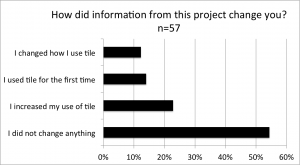
Those 57 growers were also asked why they use tile drainage. As was the case when we started in 2012, drying out beds and evening out soil moisture remained the primary reasons cited for using tile. While less than 10% cited improved yield or decreased rot as primary motivators, 70% of those that installed tiles reported improvements in both.
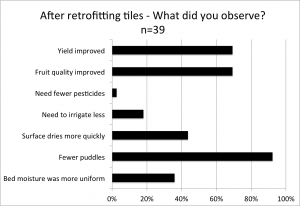
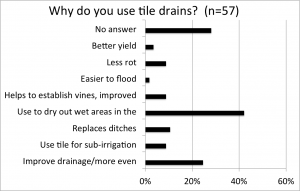
Quotes from farmers:
Mike, owner of a mid-sized cranberry farm, installs drain as retrofits in areas with drainage problems or Phytophthora root rot. He thinks the best way to install tiles is to dig a trench, add gravel, place the tile then cover with gravel. He also thinks that tiles work best when integrated together with ditches: "All the drainage in the world won’t help if your ditches are clogged with weeds and the water can’t move."
Gary, owner of a large cranberry operation, installs large areas of tile drainage as retrofits in wet areas to solve cultural problems, and is using tile in all new constructions/ renovations as standard practice. "We reviewed the practices and BMPs and used a 20-foot spacing, 8 inches deep. We hope to use the drainage tile in the future for flood irrigation, keeping the bog moist."
Keith, a small farm holder, renovated old bogs and eliminated interior ditches by installing tiles at a 20 foot spacing, 6 inches deep. Why? "The bog needed subsurface drainage and better moisture conditions. It had been reported to have root rot before I got it. I have had no problem with that since renovating with tiles."
Areas needing additional study
Our research results and our discussions with growers have made it apparent that water management remains a key issue for the cranberry industry. Drainage alone is not the answer. There is need for much more work on the integration of drainage and irrigation, including the use of practical methods to assess soil moisture as the basis for irrigation scheduling. There is also a need to further look at the integration of water and disease management with the potential to reduce reliance on fungicides in the management of root rot and fruit rot. All of these areas of management, drainage, irrigation, and diseases, have received much attention from growers and researchers. What remains is to successfully integrate all of these into a sustainable management protocol.
Information Products
- Use of Tile Drainage in Massachusetts Cranberry Production (Fact Sheet)
- Tile Drain Best Management Practices (Fact Sheet)
- 2014 Update Mtg: Tile Drainage in Massachusetts Cranberry Production - Implementation and Best Management Practices (Bulletin)
- 2016 Update Meeting: Tile drainage in Massachusetts Cranberry Production (Bulletin)